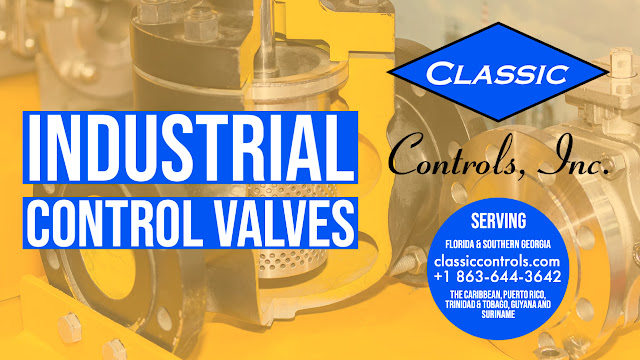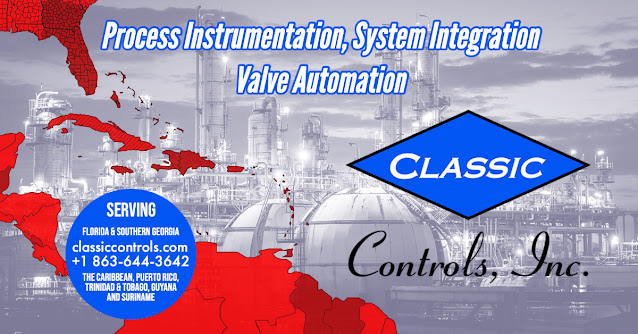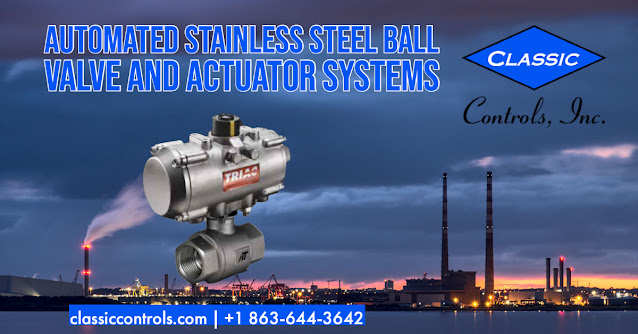An educational blog sponsored by Classic Controls focusing on education and training for the process control, instrumentation, and industrial valve community.
Industrial Control Valve Primer
There are several industrial control valves, each with unique characteristics and uses. Some common types of control valves include:
Globe valves: Globe valves are typically used for regulating flow in pipelines and are known for their ability to handle high-pressure systems. They consist of a disk that moves up and down to block or allow flow through the valve. Industrial globe valves are mechanical devices that are used to regulate the flow of liquids or gases in a pipe. They consist of a cylindrical body with a disk-shaped element, called the plug or disc, that moves up and down to open and close the valve. The disk is connected to a stem, which is operated by a handwheel, lever or pneumatic or electric actuator. When the stem is turned, it raises or lowers the disk, allowing for the flow of fluid through the valve. Globe valves are typically used in industrial settings, where precise control over the flow of fluids is important. They are known for their durability and reliability and are often used in applications such as steam systems, water treatment plants, and chemical processing facilities.
Butterfly valves: Butterfly valves are used for controlling the flow of fluids in pipelines. They consist of a disk that rotates to block or allow flow through the valve. They are known for their low cost and ease of installation. Butterfly valves are a type of industrial valve that are typically used to regulate the flow of fluids, such as gases, liquids, and slurries, in a pipe. They are called butterfly valves because the mechanism that controls the flow of the fluid is a disc that is mounted on a shaft and rotates like a butterfly's wings.
Some of the key characteristics of industrial butterfly valves include:
- They are relatively compact and lightweight compared to other types of valves, which makes them easy to install and handle.
- They are able to handle a wide range of temperatures and pressures, making them suitable for use in many different industrial applications.
- Butterfly valves are often used in applications where a tight shutoff is required, as they can provide a very tight seal when closed.
- They are typically used in applications where the fluid being controlled is either highly viscous or abrasive, as the design of the valve allows for low-friction operation and reduces the wear on the valve's components.
- Butterfly valves are available in a wide range of sizes and materials, which allows them to be tailored to the specific requirements of a particular application.
Diaphragm valves: Diaphragm valves are used for controlling the flow of fluids in pipelines. They consist of a flexible diaphragm that moves to block or allow flow through the valve. They are often used in applications where the fluid being controlled is corrosive or dirty. Industrial diaphragm valves are valves that use a flexible membrane to control the flow of liquids or gases. The membrane is typically made of rubber or another flexible material and is positioned between the valve body and the valve seat. When the valve is open, the membrane flexes to allow the flow of fluid, and when the valve is closed, the membrane seals against the valve seat to stop the flow. Diaphragm valves are commonly used in industrial piping systems for a variety of applications, such as controlling the flow of chemicals, water, steam, and other liquids and gases. They are often used in situations where the fluid being controlled is corrosive or abrasive, as the flexible membrane helps to prevent damage to the valve body.
Plug valves: Plug valves are used for controlling the flow of fluids in pipelines. They consist of a plug that rotates to block or allow flow through the valve. They are known for their ability to handle high-pressure systems and are often used in applications where the fluid being controlled is viscous. Industrial plug valves are a type of quarter-turn valve that is used in various industrial applications to control the flow of liquids and gases. They are named for the plug-shaped component that is used to open and close the valve. Some of the key characteristics of industrial plug valves include:
- Quarter-turn operation: As mentioned, industrial plug valves are quarter-turn valves, which means they can be opened and closed by rotating the valve handle or stem by 90 degrees. This allows for quick and easy operation of the valve, and is particularly useful in applications where the flow needs to be quickly shut off.
- Plug-shaped component: The core component of an industrial plug valve is the plug, which is a cylindrical piece with a hole through the center. When the plug is rotated to align the hole with the inlet and outlet ports, the valve is open and allows flow. When the plug is rotated so that the hole is perpendicular to the inlet and outlet ports, the valve is closed and blocks flow.
- Various materials and sizes: Industrial plug valves are available in a range of materials, including metal alloys, plastic, and other materials, depending on the specific application and media being controlled. They are also available in a range of sizes to accommodate different flow rates and pressure ratings.
- Multiple sealing options: Industrial plug valves can be equipped with a variety of sealing options, such as soft seats, metal seats, or a combination of both. This allows for better control of the flow and pressure, and can prevent leaks in the system.
- Low-maintenance design: Industrial plug valves are known for their low-maintenance design, which makes them a popular choice for many industrial applications. They have few moving parts and can be easily disassembled and cleaned, reducing downtime and maintenance costs.
Each type of control valve has its own unique advantages and disadvantages, and the best type of valve for a particular application will depend on the specific requirements of the system. Discuss your control valve requirements with professional, skilled application engineers. Classic Controls is available to assist in the application and specification of any valve application for any industrial or commercial process. Call them at 863-644-3642 or visit their website at https://classiccontrols.com.
FLEXIM's Disturbance Correction Overcomes Challenging Straight Run Requirements
Process Instrumentation, System Integration and Valve Automation in Florida, Southern Georgia, The Caribbean, Puerto Rico, Trinidad & Tobago, Guyana, and Suriname
Digitalization and Industrial Process Control
The industrial sector is undergoing a digital transformation. Digitalization is converting data into a digital format and digitizing industrial processes. Human operators rely on automation systems to display the process's overall status and assist them in determining when and why problems are emerging. In its simplest form, automation is the ability of a machine to perform a task more efficiently and reliably than a human. In reality, the automation system presents operators with many process variables, permitting them to interpret them as they see fit. In the event of an issue, operators must act promptly and appropriately to prevent an incident.
However, a much-preferred system is a system that can indicate the process's status and identify which sensor to focus on, and predict not only when an error occurs but if an error will occur. AI technologies can now specify the primary contributors to unusual situations and pinpoint the sensors indicating the causes. The digitalization process not only provides this accurate pinpointing but predictive analysis as well.
Industrial automation has been rising for decades, leading companies to invest in digital technology to streamline their processes. With so many companies integrating digitalization into their operations, it's no surprise that it has become an industry buzzword. Digitalization applies to any industry, but its application varies depending on what type of product or service the facility offers.
Digitalization Can Help Businesses Become More Productive And Efficient
The benefits of digitalization are manifold and include improved efficiency, more accurate measurements, and better control over production processes. For example, computers can calculate the production process more accurately and thoroughly than without them. Therefore, a computerized system will produce goods with less waste and provide higher quality control.
Digitalization has revolutionized industries such as oil & gas, manufacturing, utilities, and transportation. Implementation is now occurring in process industries such as water utilities and chemical plants. The difficulty of implementing digitalization depends on the maturity and efficiency level of the IT infrastructure and company culture. Mature organizations can leverage their existing systems to process data more efficiently. Younger organizations are more likely to identify system gaps and invest heavily in them before they become bottlenecks.
What Are the Major Concerns for Process Industries in Implementing Digitalization?
The first concern is the high cost of replacement instrumentation, communications systems, and employee training. The second concern is a lack of skilled workers to handle the new technologies. The third concern is the developing and changing communication standards for wireless networks and IIoT (Industrial Internet of Things) technology. The fourth concern is that process industries need to find legitimate partners with monitoring, control, and analytics products, plus software and the breadth of experience optimized for their industry needs.
What Is the Future for Digitalization in Process Automation and Industrial Manufacturing?
The future of digitalization in process automation and industrial manufacturing depends on developing technologies such as wireless instrumentation, cloud-based computing, IIoT, and AI. With the need to increase efficiency and reduce labor costs, we are seeing a trend in the industry where more and more companies are adopting digitalization in process automation and industrial manufacturing.
Conversion from an analog to a digital system can be expensive and laborious, but the benefits of connecting devices with other devices safely, efficiently, and reliably are becoming apparent. Digitalization provides lower costs because there is less downtime and less need for complex wiring or regular on-site inspections. However, these benefits include new expenses such as software subscriptions, maintenance plans, and upgrades.
Yokogawa and Process Industry Digitalization
Yokogawa has over 100 years of industrial process experience and vast amounts of accumulated knowledge in process control. Their knowledge crosses all industrial sectors, and they have more than 20 years of deep investment in digitalization. They assist their customers with digital transformation using their pressure, temperature, flow, level, vibration monitoring, and analytical instrumentation expertise. With this expertise and their global experience in using information and control technology, Yokogawa is world renowned for improving the process industries' safety, sustainability, and efficiency.
For more information about Yokogawa process control systems and components in Florida, the Caribbean and Puerto Rico, contact Classic Controls. Call +1 863-644-3642 or visit https://classiccontrols.com.
Control Valve Application Tips
- Control valves are not isolation valves. Don't apply them as such.
- Always carefully choose the suitable construction material. Consider the valve components that come into contact with the process medium, such as the valve body, seat, and other "wetted" portions. Consider the control valve operational pressure and temperature exposure. Finally, examine the surrounding environment and any corrosives that may arise and affect the outside of the valve.
- Place the flow sensor upstream of the control valve. When the flow sensor is downstream of the control valve, it senses a less stable flow stream created by turbulent flow in the valve cavity.
- Consider the degree of control you need and ensure that your valve's design will provide the controllability you require.
- Excessive dead-band leads to hunting and poor control. The change of input signal necessary to induce a change in valve position is dead-band. Dead-band is affected by worn or loosely fitting mechanical linkages or a controller setting. It may also be affected by mechanical sensor tolerances, friction in the valve stems and seats, or an undersized actuator.
- Think about stiction. Stiction is the propensity of valves that have had very little motion or have not moved at all to "stick." It is usually produced by the valves, packing glands, seats, or the pressure applied to the disk.
- Make sure your loop controller is appropriately tuned. Overshoot, undershoot, and hunting are symptoms of a poorly tuned controller. Check your proportional, integral, and derivative controller settings. Today, employing controllers with powerful, accurate auto-tuning capabilities that have replaced the old-fashioned trial and error loop tuning approach, is relatively simple.
- Avoid oversizing your control valve. Control valves are usually oversized for the flow loop they control. A tiny change in valve position has a considerable influence on flow. If the control valve is too large, only a fraction of its valve travel occurs, causing the valve to hunt, leading to severe wear. Always size a control valve to allow 70-90 percent of travel.
- Consider the kind of control valve you're employing and its inherent flow characteristics. Flow properties vary greatly across valve types and their disks (or profiles). The flow characteristic is the change in flow rate in response to a change in valve position. The linear features of globe control valves are preferable, while the non-linear flow characteristics of butterfly and gate valves might pose control issues. Manufacturers add specifically designed disks or flow orifices that provide a custom flow profile to establish a linear flow characteristic via a non-linear control valve.








